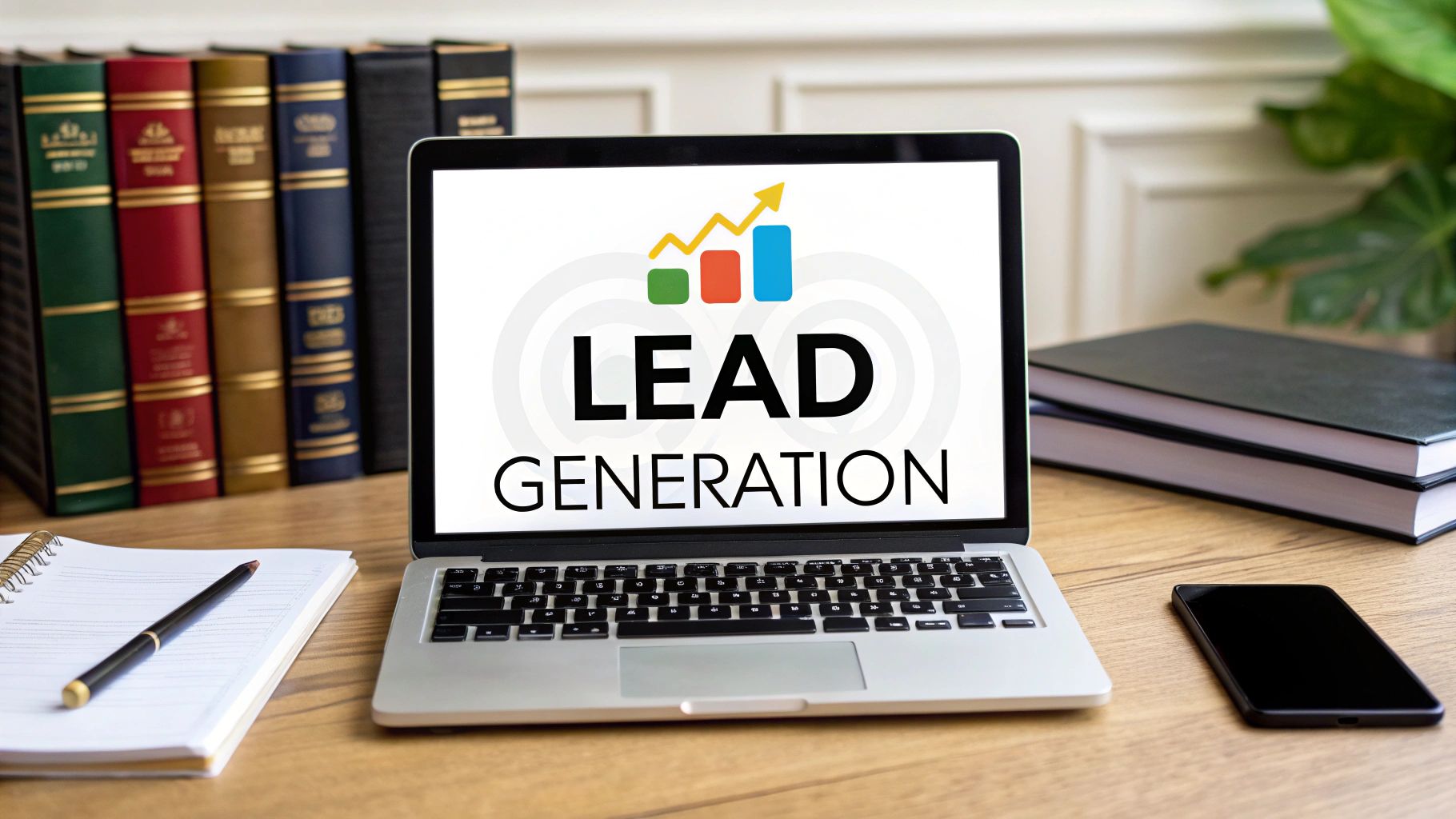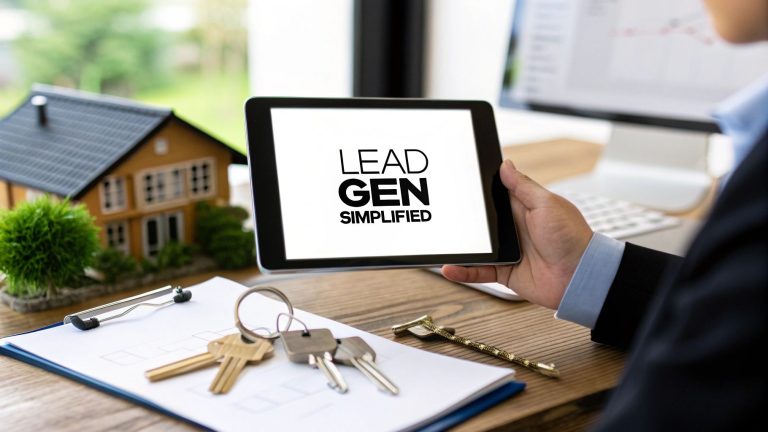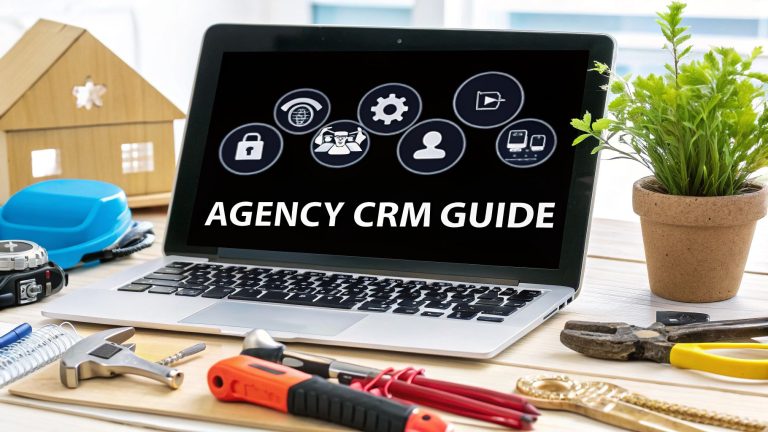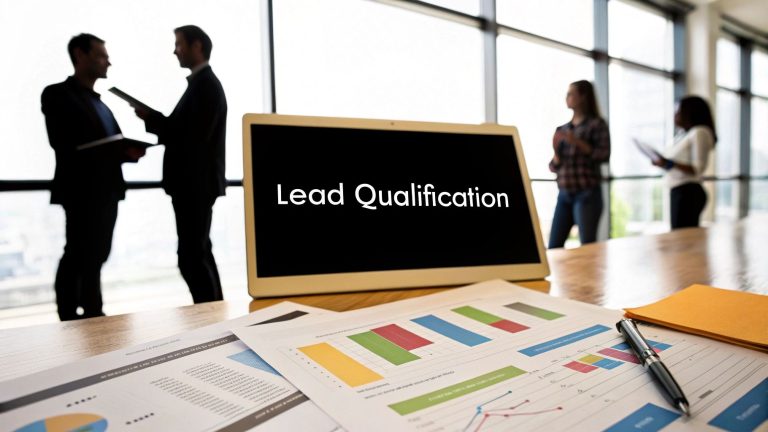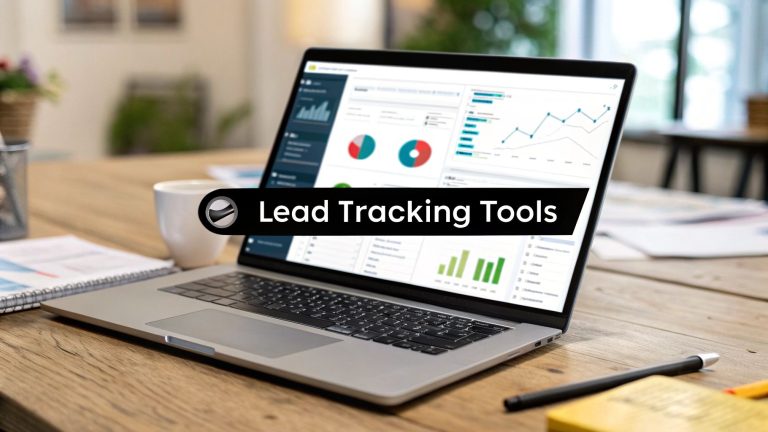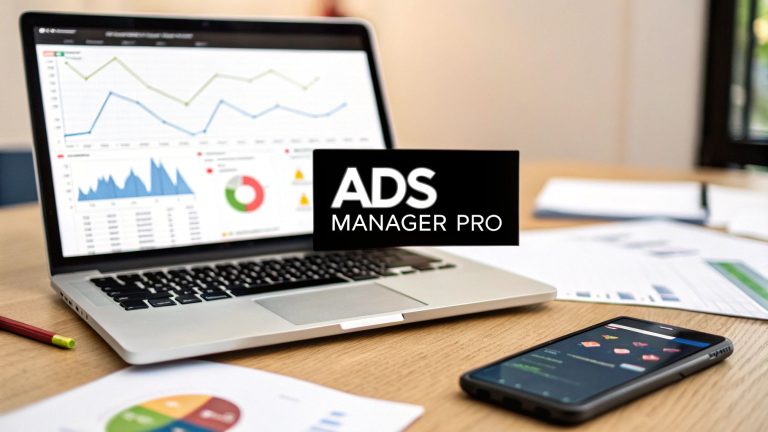A Modern Guide to Lead Generation for Attorneys
Gone are the days when a law firm could thrive on referrals alone. To grow consistently, you need a predictable client acquisition system—a well-oiled machine that runs on modern digital marketing. This isn't just theory; it's a practical blueprint for building that very engine.
Building Your Law Firm's Growth Engine
The legal world has shifted. If you're wondering where your clients are, look online. Today, a staggering 76% of legal consumers kick off their search for an attorney on the web, making a strong digital footprint an absolute must-have.
This move from old-school networking to digital channels is your opportunity to create a steady, reliable stream of qualified prospects. It's about building a system with three core pillars: Attracting the right people, managing them efficiently, and scaling your efforts.
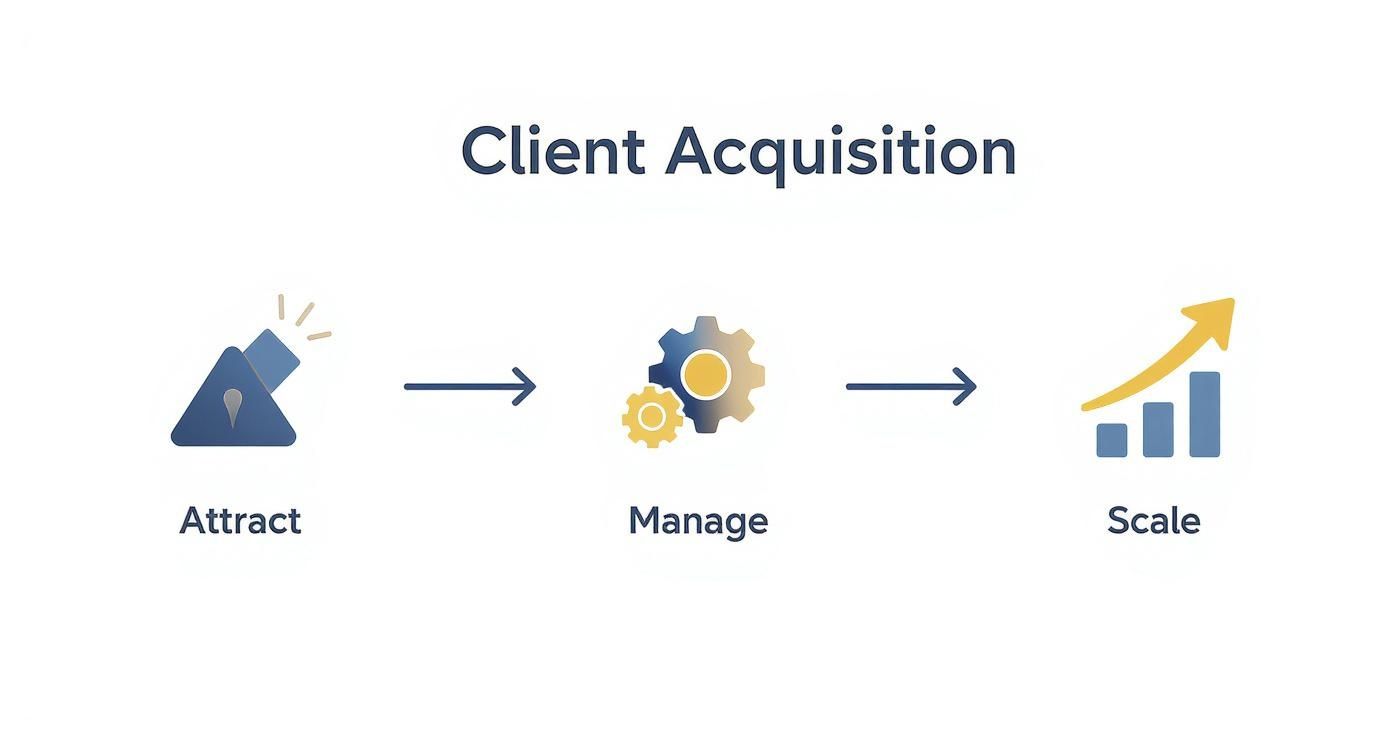
As you can see, getting a potential client’s attention is just the first step. How you manage that initial contact is what truly drives conversions and sets the stage for your firm’s growth.
The real goal here is to create a scalable engine that consistently brings in high-quality cases. This frees you up to practice law instead of constantly stressing about where the next client is coming from.
This guide will walk you through exactly how to build this modern system. We're going to cover:
- Pinpointing the exact clients you actually want to work with.
- Launching targeted ad campaigns that reach them where they are.
- Putting automated systems in place to handle new inquiries without a hitch.
By weaving these elements together, you can finally stop reacting to the unpredictable ebb and flow of referrals and start proactively building your firm's future. To get a better handle on the tech that makes this possible, check out our deep dive on the relationship between a CRM and lead generation.
Key Lead Generation Channels for Law Firms
To build an effective system, it helps to know which channels pack the most punch. While there are many options, a few consistently deliver the best results for attorneys today.
| Channel | Primary Strength | Best For |
|---|---|---|
| Google Ads (PPC) | High-Intent Leads | Capturing clients actively searching for specific legal services right now. |
| Facebook Lead Ads | Precise Targeting | Reaching specific demographics and interest groups before they even start searching. |
| Local SEO | Geographic Dominance | Attracting local clients searching for "lawyers near me" and similar queries. |
| Content Marketing | Building Authority | Establishing trust and credibility by answering potential clients' legal questions. |
| Email Marketing | Nurturing Leads | Staying top-of-mind with prospects who aren't ready to hire immediately. |
Each channel serves a different purpose, but when integrated, they create a powerful and comprehensive client acquisition strategy.
Pinpointing Your Ideal High-Value Client
Every lawyer knows that effective lead generation doesn't start with a flashy ad campaign. It starts with a simple question: who are you really trying to reach?
If your marketing is generic, you're going to attract generic, low-value inquiries that waste everyone's time. To build a system that consistently delivers high-quality cases, you first have to get crystal clear on your Ideal Client Profile (ICP).
This goes way beyond basic demographics like age or location. You need to dig into the psychographics—the human element behind the legal mess. What specific problem is keeping them up at night? What are their biggest fears and frustrations right now? What does a "win" actually look like from their perspective?

Think about it. A personal injury attorney's ideal client isn't just "someone in a car accident." A truly high-value ICP is far more specific.
Example ICP: Personal Injury Firm
- Who: A 45-year-old tradesperson, the primary earner for their household.
- Problem: Suffered a debilitating back injury on the job and can no longer work.
- Fears: Drowning in medical bills, losing their home, and failing to provide for their family.
- Frustration: Feels bullied and confused by the insurance company's lowball offers and endless paperwork.
- Desired Outcome: Fair compensation to cover bills and future care, plus the peace of mind that their family is secure.
See the difference? This level of detail completely changes your marketing. Instead of running generic ads about "getting the compensation you deserve," you can create messaging that speaks directly to that tradesperson's very real fear of financial ruin. That's how you build an instant connection.
Building Your Firm's ICP Framework
So, how do you apply this to your own firm? Start by looking back at your best past cases. And I don't just mean the ones that brought in the most revenue. Think about the clients who were a pleasure to work with, whose cases you were passionate about, and who genuinely valued your expertise.
Look for the common threads among them:
- Trigger Events: What specific event pushed them to finally pick up the phone and call you?
- Emotional State: When they first reached out, were they overwhelmed, angry, scared, or just plain confused?
- Communication Style: Did they prefer direct, no-nonsense updates, or did they need more frequent, reassuring communication?
- Information Sources: Where did they look for answers before they found you? (Think Google searches, specific online forums, or Facebook groups.)
Answering these questions for each of your key practice areas gives you the raw material for powerful, resonant marketing. It ensures every dollar you spend is aimed squarely at attracting clients who are not only profitable but also a perfect fit for your firm. This process is a foundational part of screening potential clients—something you can dive deeper into with our comprehensive lead qualification checklist to really dial in your intake.
Now that you have your Ideal Client Profile locked in, it's time to put it to work. We need to go where your potential clients are already spending their time—and for most people, that means social media. For attorneys, this isn't about getting random clicks; it's about crafting targeted ads that bring in genuine, high-quality cases.
This is where Facebook Lead Ads come in. They are built for one specific purpose: to capture a prospect's information without ever forcing them to leave the app. This is a game-changer. It eliminates friction, especially for people on their phones, and dramatically increases the odds they'll complete your form. The whole experience is seamless.
To kick things off, you'll start your campaign inside the Facebook Ads interface by selecting the "Leads" objective.
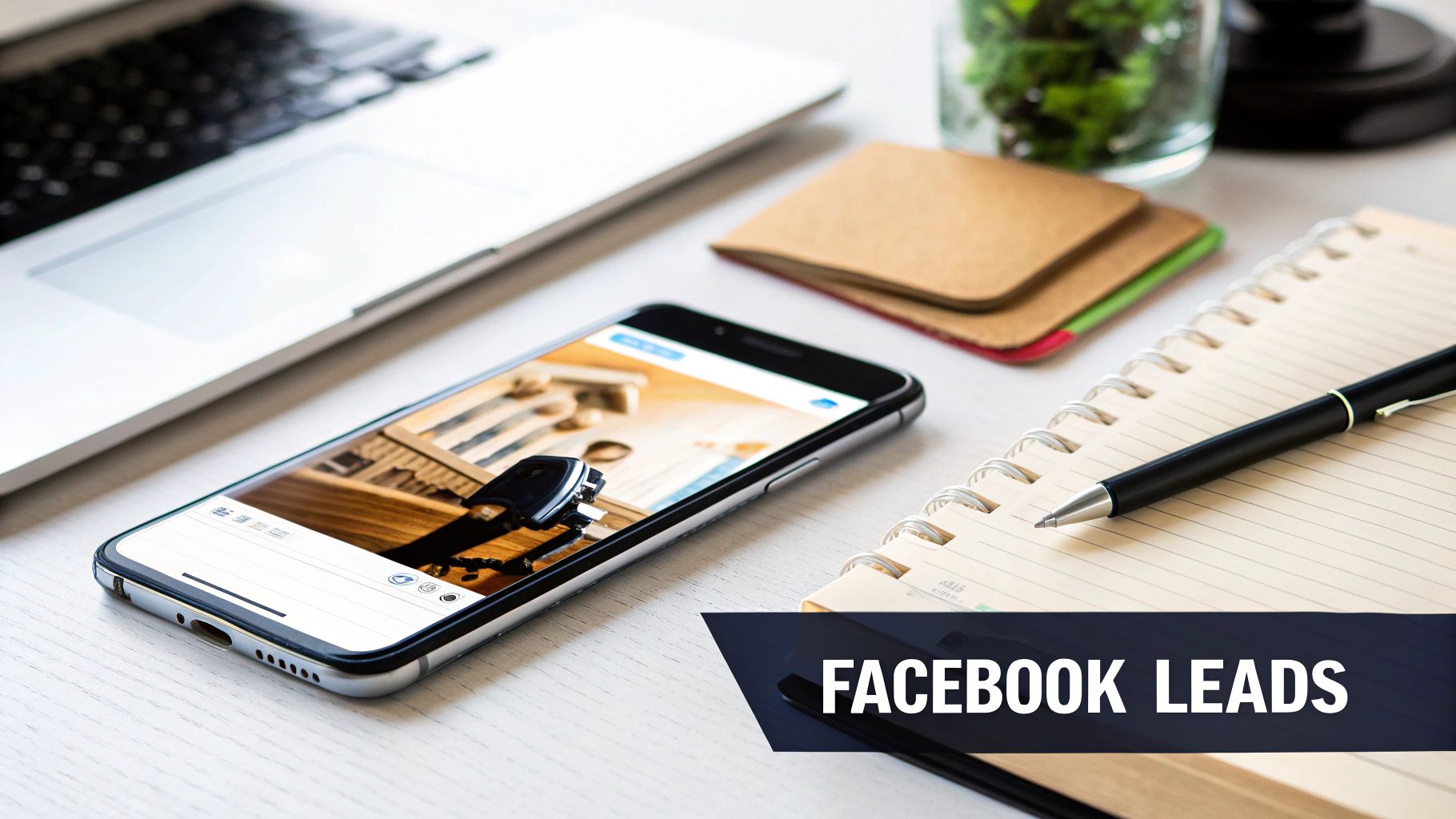
Making this choice right at the start is crucial. It tells Facebook's algorithm exactly what you want, so it can optimize your ad delivery to find people most likely to actually fill out your form.
Targeting The Right Audience
This is the moment your ICP becomes your most powerful asset. Forget casting a wide, expensive net. Instead, you'll use Facebook’s incredibly detailed targeting to zero in on the exact people who match your ideal client. You can layer different factors to build the perfect audience.
- Demographics: Go beyond age and location. A family law attorney can target users with life events like "Recently Engaged," while a real estate lawyer might focus on "New Movers."
- Interests: Think about what your ideal clients are interested in. A business lawyer could target users interested in "small business financing" or those who follow entrepreneurial pages.
- Behaviors: This is where it gets really powerful. You can target based on behaviors like "small business owner," which is pure gold for commercial litigation or corporate law practices.
Getting this right from the beginning ensures every dollar of your ad budget is spent showing your message to people who are far more likely to need your services. For a much deeper dive, check out our guide on advanced Facebook Ads targeting options.
Crafting Ad Copy That Converts
Your ad copy has a big job to do, and it needs to do it fast. It has to grab attention, build a sliver of trust, and push for action. Ditch the generic legal jargon nobody understands. Speak directly to the pain points you uncovered when building your ICP.
Here's an example:
Headline: Worried About Mounting Medical Bills After Your Accident?
Body Text: The insurance company's first offer probably won't cover your future expenses. Don't sign anything without getting a free, no-obligation case review from a team that fights for people, not corporations. We've helped hundreds of people in [Your City] get the compensation they truly deserve.
Call-to-Action: Get a Free Case Review
See the difference? This approach is empathetic and focuses on a solution. It pinpoints a specific fear (medical bills) and offers a clear, risk-free next step. This kind of direct, problem-solving message is what works.
Don't just take my word for it. Research shows that 71% of lawyers have successfully generated new leads from social media. In fact, a well-run social media marketing campaign can deliver nearly double the leads of traditional methods, with an impressive average conversion rate of 4% from organic traffic. You can read the full analysis on the effectiveness of legal marketing on seoprofy.com.
Automating Your Lead Intake Process
Getting a steady stream of inquiries from your Facebook Ads is a huge win, but that’s really only half the battle. The real make-or-break moment for law firm lead generation is how you manage that flood of new information.
If your current process involves someone manually downloading a CSV file from Facebook, then re-typing all that data into your practice management software… you're not just wasting time. You're actively losing potential clients.
Every single minute a new lead has to wait for a response, their interest cools. The goal is to shrink that gap between the moment they hit "submit" on your ad and your very first contact. This is where automation becomes your firm's most valuable player, ensuring every lead is captured, categorized, and sitting in front of your team instantly.
Building Your Automated Intake Bridge
To pull this off, you’ll need an automation tool. Think of it as a digital translator that lets two completely different pieces of software—like Facebook and your legal CRM—speak the same language fluently. You're building a workflow where a new lead submission on Facebook immediately kicks off a series of actions in your CRM.
Here’s a real-world look at how this "bridge" works:
- The Trigger: A potential client in your target city sees your ad for "divorce representation," clicks it, and fills out the Facebook Lead Form with their contact details.
- The Action: The automation tool catches this new submission the second it happens.
- The Handoff: It instantly creates a new contact and a new matter in your legal CRM, automatically filling in the name, email, and phone number from the Facebook form.
This all happens in seconds. No human intervention needed. Your intake team gets an immediate notification that a new, qualified lead is ready for them to contact.
By automating your intake, you transform your lead generation from a reactive, manual chore into a proactive, scalable system. It's the engine that powers a truly modern client acquisition strategy.
Tagging and Organizing for Success
A smart automation workflow does a lot more than just move data from point A to point B; it organizes it for you on the way. You can set up your automation to apply specific tags to each incoming lead based on which ad they came from.
This is incredibly useful for staying organized and, later, for analyzing your results. For example:
- Lead Source: Automatically slap a tag like
Facebook Leadon every single inquiry from the platform. - Practice Area: If the ad was about family law, add a
Family Lawtag. - Ad Campaign: You can get even more granular by tagging leads from a specific campaign, like
Q3 Divorce Campaign.
Now, when a lead lands in your CRM, it isn't just a name and a phone number—it's a fully categorized prospect. Your team knows who they are, where they came from, and the specific legal issue they’re facing right off the bat. This level of organization is essential for a personalized follow-up and for accurately measuring the ROI of every dollar you spend on ads.
Of course, to make sure your new leads are handled with maximum efficiency, it pays to look beyond just the initial intake and consider the benefits of automating your firm's legal workflows from start to finish.
Crafting an Unbeatable Follow-Up Sequence
When it comes to online lead generation for attorneys, speed is everything. A prospect who fills out your form isn't just window shopping—they're actively looking for help right now. An immediate, professional response can be the single most important factor in converting that inquiry into a paying client.
This is where you build an automated, yet deeply personal, follow-up workflow. The goal is to make every potential client feel seen and prioritized from the moment they click "submit." A multi-channel sequence ensures your firm stays top-of-mind during that critical decision-making window.

This isn't just about being fast; it's about being strategic. Every lead represents a significant investment. The cost per lead for law firms often falls between $50 to $300, and high-value practice areas like personal injury or family law can easily push that even higher. A well-crafted follow-up system maximizes your return on that investment, making sure fewer high-intent leads slip through the cracks. For more on this, check out the insights on optimizing legal lead costs from LegalClerk.ai.
The First Five Minutes are Everything
The moment a lead lands from your Facebook Ad, your automated system needs to spring into action. This initial contact is far too important to leave to chance or manual effort.
- Instant Automated SMS: The very first touchpoint should be a text message. SMS open rates are through the roof, and it feels immediate and personal. The message should be simple and set expectations perfectly.
- Example: Hi [First Name], this is [Your Name] from [Firm Name]. I just received your inquiry about your case and will be calling you from this number in the next few minutes. Thank you.
- Immediate Introductory Email: At the same time, an automated email should go out. This message confirms you received their info, introduces the firm, and provides more context than a quick text can. Be sure to include a professional signature and a link to your firm’s website.
This two-pronged attack ensures you reach the prospect on their preferred channel, making your firm look organized and incredibly responsive from the get-go.
Remember, the person who responds first often wins the case. Automating these initial touchpoints guarantees you are always the first to make contact, day or night.
The Next 72 Hours
After that initial automated outreach, the process shifts to a structured, human-driven follow-up managed by your intake team. Your CRM should automatically create tasks to guide this process so nothing ever gets forgotten.
Here’s what a persistent but professional sequence might look like:
- Call Attempt 1 (Within 10 Minutes): Your intake specialist makes the first call, just as promised in the SMS. If there's no answer, they leave a concise voicemail.
- Email 2 (24 Hours Later): A personalized email follows up on the voicemail. This isn't just another template; it should reference their initial inquiry and offer something valuable, like a link to a relevant blog post on your site.
- Call Attempt 2 (48 Hours Later): A second call is placed, ideally at a different time of day to increase the chances of connecting.
- SMS 2 (72 Hours Later): A final, gentle follow-up text can be surprisingly effective.
- Example: Hi [First Name], just following up on the case review you requested. Please let me know if you have a moment to connect this week. -[Your Name], [Firm Name]
This structured sequence strikes the perfect balance between persistence and professionalism. It proves that your firm is serious about helping them without coming across as pushy. This system transforms your lead follow-up from a chaotic scramble into a predictable, client-winning machine.
Measuring and Optimizing Your Campaign Performance
Getting your ads live and seeing leads come into your CRM is a great start, but it’s just that—a start. A successful lead generation system is never a 'set it and forget it' operation. The real work begins after you launch. This is where you shift from just running a campaign to building a lean, efficient client acquisition machine.
First things first: you have to look beyond the vanity metrics. Sure, seeing a high number of 'likes' or 'reach' feels good, but those numbers don't pay the bills. True performance is measured by data that directly impacts your firm’s bottom line.
Core Metrics That Actually Matter for Attorneys
Your Facebook Ads dashboard is flooded with data, but you really only need to obsess over a few key performance indicators (KPIs) to see what's actually happening. These metrics tell the real story about your campaign’s health and, more importantly, its profitability.
Here's where to focus your attention:
- Cost Per Lead (CPL): This one is straightforward. It tells you exactly how much you're spending to get one person's contact information. Your constant goal should be to push this number down without letting lead quality suffer.
- Lead-to-Client Conversion Rate: This is the bridge between your marketing efforts and your intake team. It answers the most important question: "Of all the leads we generated, what percentage actually hired us?" This metric cuts through the noise and reveals the true quality of the inquiries you're getting.
- Return on Ad Spend (ROAS): This is the ultimate measure of success. For every single dollar you put into your ad campaign, how many dollars in revenue did you get back? A ROAS of 5:1 is fantastic—it means you generated $5 for every $1 you spent.
Tracking these numbers religiously moves you from guessing to knowing. It gives you the hard data to justify your marketing budget, make smart decisions, and double down on what’s actually working.
A data-driven approach isn't optional for effective attorney lead generation. It stops you from burning cash on ads that don't perform and gives you the confidence to scale the campaigns that bring in high-value cases.
The Power of A/B Testing
Once you have a baseline for your metrics, you can start making them better through systematic A/B testing, or split testing. The idea is simple: you create two versions of an ad, change only one thing, and see which one performs better.
You can test almost any part of your campaign. For example:
- Ad Creative: Try a professional photo of yourself against a more generic stock image of a gavel.
- Headline: Pit a question-based headline like "Injured at Work?" against a direct statement like "Get the Compensation You Deserve."
- Target Audience: Test a broad, interest-based audience against a more targeted lookalike audience built from your past clients.
By isolating just one variable, you learn exactly what resonates with your ideal clients. This constant cycle of testing and refining is how you methodically lower your Cost Per Lead and improve the quality of your inquiries over time.
As you get more sophisticated, you can even implement a lead scoring system to automatically prioritize your best prospects. If you want to dive deeper into that, check out a comprehensive HubSpot lead scoring guide.
Got Questions About Lead Generation? We've Got Answers.
Stepping into the world of digital marketing can feel like a minefield, especially when you’re also running a busy law practice. It's totally normal to have questions about where to put your money, what actually works, and how to approach the whole thing.
Let's cut through the noise and tackle some of the most common questions we hear from attorneys. Getting some clarity here can save you a ton of time and money down the road, and it’s the key to building a system that brings real, measurable results to your firm.
How Much Should We Really Budget for Digital Ads?
There’s no magic number here. Your ideal budget really depends on your practice area and how competitive your local market is.
That said, a solid, practical starting point for most law firms is somewhere between $1,500 and $3,000 per month for a single platform like Facebook or Google Ads.
This is usually enough to get the ball rolling, gather some meaningful data, and start seeing a real return. More importantly, it lets you figure out your average Cost Per Lead (CPL). Once you know that crucial number, the conversation changes. Your ad budget stops being an "expense" and starts becoming a predictable "investment."
When you can confidently say that every $100 you spend on ads brings in a client worth $5,000, the question is no longer, "How much should I spend?" It becomes, "How much do I want to grow?"
For Immediate Leads, Should I Use SEO or Paid Ads?
If you want your phone to ring this week, paid advertising is the undisputed champ. Simple as that. A well-built Google or Facebook Ads campaign can start generating qualified inquiries within 24 to 48 hours of going live. It’s an immediate, controllable stream of potential new clients.
Search Engine Optimization (SEO), on the other hand, is the long game. It’s an incredibly powerful asset that involves getting your website to rank at the top of Google organically. This builds massive credibility and generates "free" leads over time. But let's be realistic—seeing significant results from SEO is a 6 to 12-month commitment.
The smartest firms do both.
- Paid Ads: Use them for a consistent, predictable flow of leads right now.
- SEO: Invest in it at the same time to build a sustainable, long-term asset for your firm's future.
How Can I Make Sure the Leads I Get Are Actually Good?
High-quality leads don't happen by accident. They’re the direct result of a smart strategy built on three pillars: targeting, messaging, and qualification.
First, your ad targeting needs to be laser-focused on that Ideal Client Profile we talked about earlier. Then, your ad copy and images have to speak directly to their specific legal problem. This automatically weeds out people who aren’t a good fit.
Finally, you need to use your lead form or landing page to ask a simple, powerful qualifying question. For instance, a personal injury attorney could add a checkbox that asks, "Were you hospitalized for your injuries?" This tiny step screens out weaker inquiries before they even land on your intake team's desk, freeing them up to focus on the most promising cases.
Should We Handle Marketing In-House or Hire an Agency?
This really comes down to a gut check on your firm's available time, in-house skills, and budget.
Doing it yourself gives you total control, but it also means a massive time commitment and a very steep learning curve. Hiring a specialized legal marketing agency puts the work in the hands of seasoned experts who can get you results much faster, but it comes with a higher price tag.
For many small to mid-sized firms, a hybrid approach often hits the sweet spot. You could bring in a consultant to build the core lead generation system and then train your internal team to manage the day-to-day operations. It's the best of both worlds—you get expert strategy and maintain daily control.
Ready to stop wasting time with manual downloads and instantly sync your Facebook leads to your CRM? LeadSavvy Pro automates the entire process, ensuring you can respond to new prospects in seconds. Start for free and see how it works.

